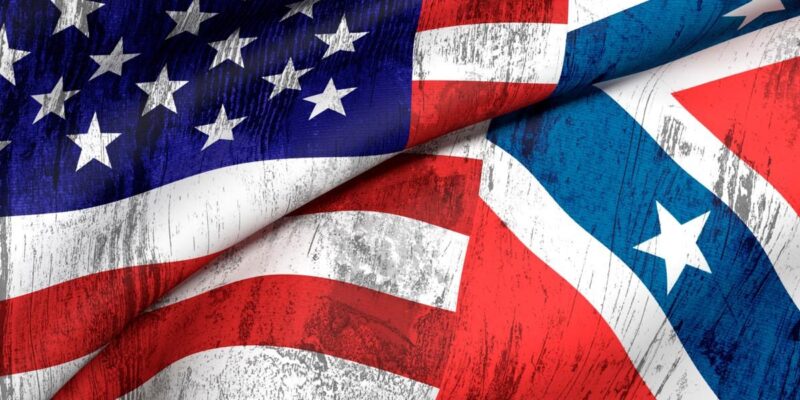
[This article is excerpted from a 30,000-word memo to the Volker Fund, 1961. The full memo is available in Strictly Confidential: The Private Volker Fund Memos of Murray N. Rothbard edited by David Gordon.]
The Road to Civil War
The road to Civil War must be divided into two parts:
the causes of the controversy over slavery leading to secession, andthe immediate causes of the war itself.
The reason for such split is that secession need not have led to Civil War, despite the assumption to the contrary by most historians.
The basic root of the controversy over slavery to secession, in my opinion, was the aggressive, expansionist aims of the Southern “slavocracy.” Very few Northerners proposed to abolish slavery in the Southern states by aggressive war; the objection – and certainly a proper one – was to the attempt of the Southern slavocracy to extend the slave system to the Western territories. The apologia that the Southerners feared that eventually they might be outnumbered and that federal abolition might ensue is no excuse; it is the age-old alibi for “preventive war.” Not only did the expansionist aim of the slavocracy to protect slavery by federal fiat in the territories as “property” aim to foist the immoral system of slavery on Western territories; it even violated the principles of states’ rights to which the South was supposedly devoted – and which would logically have led to a “popular sovereignty” doctrine.
Actually, with Texas in the Union, there was no hope of gaining substantial support for slavery in any of the territories except Kansas, and this had supposedly been settled by the Missouri Compromise. “Free-Soil” principles for the Western territories could therefore have been easily established without disruption of existing affairs, if not for the continual aggressive push and trouble making of the South.
If Van Buren had been president, he might have been able to drive through Congress the free-soil principles of the Wilmot Proviso, and that would have been that. As it was, President Taylor’s bill would have settled the Western territory problem by simply adopting “popular sovereignty” principles in New Mexico, Utah, Oregon, and California territories – admitting them all eventually as free states. Instead, the unfortunate death of President Taylor, and the accession of Fillmore, ended this simple and straightforward solution, and brought forth the pernicious so-called “Compromise” of 1850, which exacerbated rather than reduced interstate tensions by adding to the essential Taylor program provisions for stricter enforcement of the Fugitive Slave Law. Since the Fugitive Slave Law not only forced the Northern people to collaborate in what they considered – correctly – to be moral crime, but also violated Northern state rights, the strict Fugitive Slave Law was a constant irritant to the North.
The shift from free-soil principles in the Democratic Party and toward the Compromise of 1850 wrecked the old Jacksonian Democracy. The open break became apparent in Van Buren and the Free Soil candidacy of 1848; the failure of the Democratic Party to take an antislavery stand pushed the old libertarians into Free Soil or other alliances, even into the new Republican Party eventually: this tragic split in the Democratic Party lost it its libertarian conscience and drive.
Pro-southern domination of the Democratic Party in the 1850s, with Pierce and Buchanan, the opening up of the Kansas territory to slave expansion (or potential slave expansion) in 1854, led to the creation of the antislavery Republican Party. One tragedy here is that the surrender of the Democrat and Whig parties to the spirit of the Compromise of 1850 forced the free-soilers into a new party that was not only free soil, but showed dangerous signs (in Seward and others) of ultimately preparing for an abolitionist war against the South. Thus, Southern trouble making shifted Northern sentiment into potentially dangerous channels. Not only that: it also welded in the Republican Party a vehicle dedicated, multifold, to old Federalist-Whig principles: to high tariffs, to internal improvements and government subsidies, to paper money and government banking, etc. Libertarian principles were now split between the two parties.
The fantastic Dred Scott decision changed the political scene completely: for in it the Supreme Court had apparently outlawed free-soil principles, even including the Missouri Compromise. There was now only one course left to the lovers of freedom short of open rebellion against the Court, or Garrison’s secession by the North from a Constitution that had indeed become a “compact with Hell”; and that escape hatch was Stephen Douglas’s popular sovereignty doctrine, in its “Freeport” corollary: i.e., in quiet, local nullification of the Dred Scott decision.
At this critical juncture, the South continued on its suicidal course by breaking with Douglas, insistent on the full Dred Scott principle, and leading to the victory of their enemy Lincoln. Here again, secession was only “preventive,” as Lincoln had given no indication of moving to repress slavery in the South.
It is here that we must split our analysis of the “causes of the Civil War”; for, while this analysis leads, in my view, to a “pro-Northern” position in the slavery-in-the-territories struggles of the 1850s, it leads, paradoxically, to a “pro-Southern” position in the Civil War itself. For secession need not, and should not, have been combated by the North; and so we must pin the blame on the North for aggressive war against the seceding South. The war was launched in the shift from the original Northern position (by Garrison included) to “let our erring sisters depart in peace” to the determination to crush the South to save that mythical abstraction known as the “Union” – and in this shift, we must put a large portion of the blame upon the maneuvering of Lincoln to induce the Southerners to fire the first shot on Fort Sumter – after which point, flag-waving could and did take over.
The War Against the South and Its Consequences
The Civil War was one of the most momentous events in American history, not only for its inherent drama and destruction, but because of the fateful consequences for America that flowed from it.
We have said above that the War of 1812 had devastating consequences for the libertarian movement; indeed, it might be said that it took twenty years of devotion and hard work for the Jacksonian movement to undo the étatist consequences of that utter failure of a war. It is the measure of the statist consequences of the Civil War that America never recovered from it: never again was the libertarian movement to have a party of its own, or as close a chance at success. Hamiltonian neo-Federalism beyond the wildest dreams of even a J.Q. Adams had either been foisted permanently on America, or had been inaugurated, to be later fulfilled.
Let us trace the leading consequences of the War Against the South: there is, first, the enormous toll of death, injury, and destruction. There is the complete setting aside of the civilized “rules of war” that Western civilization had laboriously been erecting for centuries: instead, a total war against the civilian population was launched against the South. The symbol of this barbaric and savage oppression was, of course, Sherman’s march through Georgia and the rest of the South, the burning of Atlanta, etc. (For the military significance of this reversion to barbarism, see F.J.P. Veale, Advance to Barbarism). Another consequence, of course, was the ending of effective states’ rights, and of the perfectly logical and reasonable right of secession – or, for that matter, nullification. From now on, the Union was a strictly compulsory entity.
Further, the Civil War foisted upon the country the elimination of Jacksonian hard money: the greenbacks established government fiat paper, which it took 14 long years to tame; and the National Bank Act ended the separation of government from banking, effectively quasi-nationalizing and regulating the banking system, and creating an engine of governmentally sponsored inflation.
So ruthlessly did the Lincoln administration overturn the old banking system (including the effective outlawing of state bank notes) that it became almost impossible to achieve a return – impossible that is, without a radical and almost revolutionary will for hard money, which did not exist. On the tariff, the virtual destruction of the Democratic Party led to the foisting of a high, protective tariff to remain for a generation – indeed, permanently, for the old prewar low tariff was never to return. It was behind this wall of tariff-subsidy that the “trusts” were able to form. Further, the administration embarked on a vast program of subsidies to favored businesses: land grants to railroads, etc. The Post Office was later monopolized and private postal services outlawed. The national debt skyrocketed, the budget increased greatly and permanently, and taxes increased greatly – including the first permanent foisting on America of excise taxation, especially on whiskey and tobacco.
Thus, on every point of the old Federalist-Whig vs. Democrat-Republican controversy, the Civil War and the Lincoln administration achieved a neo-Federalist triumph that was complete right down the line. And the crushing of the South, the military Reconstruction period, etc. assured that the Democratic Party would not rise again to challenge this settlement for at least a generation. And when it did rise, it would have a much tougher row to hoe than did Van Buren and Co. in an era much more disposed to laissez-faire.
But this was not all: for the Civil War saw also the inauguration of despotic and dictatorial methods beyond the dreams of the so-called “despots of ’98.” Militarism ran rampant, with the arrogant suspension of habeas corpus, the crushing and mass arrests in Maryland, Kentucky, etc.; the suppression of civil liberties and opposition against the war, among the propeace “Copperheads” – the persecution of Vallandigham, etc.; and the institution of conscription. Also introduced on the American scene at this time was the income tax, reluctantly abandoned later, but to reappear. Federal aid to education began in earnest and permanently with federal land grants for state agricultural colleges. There was no longer any talk, of course, about abolition of the standing army or the navy. Almost everything, in short, that is currently evil on the American political scene, had its roots and its beginnings in the Civil War.
Because of the slavery controversy of the 1850s, there was no longer a single libertarian party in America, as the Democratic had been. Now the free-soilers had left the Democrat ranks. But, especially after Dred Scott had pushed the Douglas “Freeport Doctrine” to the fore as libertarian policy, there was hope for a reunited Democracy, especially since the Democrat party was still very good on all questions except slavery. But the Civil War wrecked all that, and monolithic Republican rule could impress its neo-Federalist program on America to such an extent as to make it extremely difficult to uproot.








